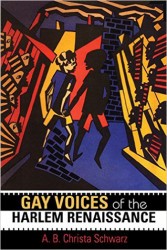
Gay Voices of the Harlem Renaissance
by A.B. Christa Schwarz
Published by Indiana University Press
Published July 18, 2003
History
224 pgs. • Find on Amazon.com
Reviewed by Stephen O. Murray
Steven Watson’s The Harlem Renaissance, the best introduction to the subject, made it clear that the sexual orientation of a high percentage of its main male writers was to other males (many of the female singers were also same-sex oriented; the main female writers don’t seem to have been).
In Gay Voices of the Harlem Renaissance (2003), Christa Schwarz focuses on four of the male writers ranging in conventionality in literary forms from poet Countée Cullen, to the “niggerati” writers Langston Hughes and Richard Bruce Nugent, and the Jamaican-born poet turned best-selling novelist Claude McKay. McKay’s pimp-and-prostitute-filled 1928 novel Home to Harlem was welcomed by Hughes, who was an advocate for writing about the black masses rather than “the talent tenth” of role models for betterment/civilization.
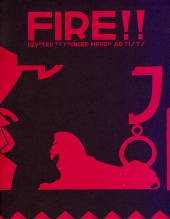 Those who published (outside the legendary niggerati one-issue magazine Fire!! edited by Thurman) were evasive about their sexual lived experience, writing in code that would register on those not in-the-know, avoiding pronouns in their love poetry (Cullen, Hughes), and crafting statements about character’s homosexuality that could be read in non-sexual ways (a specialty of McKay’s). Homosexual desire is not entirely about what bodies do, and longings for comradeship loom large in writings by Hughes and McKay—both of whom were Communist fellow-travelers, if not Communists, both of whom worked on ships and railroads.
Those who published (outside the legendary niggerati one-issue magazine Fire!! edited by Thurman) were evasive about their sexual lived experience, writing in code that would register on those not in-the-know, avoiding pronouns in their love poetry (Cullen, Hughes), and crafting statements about character’s homosexuality that could be read in non-sexual ways (a specialty of McKay’s). Homosexual desire is not entirely about what bodies do, and longings for comradeship loom large in writings by Hughes and McKay—both of whom were Communist fellow-travelers, if not Communists, both of whom worked on ships and railroads.
Focused on oblique-to-opaque sexual politics and more directly stated racial politics, Schwarz writes little about class-based politics. McKay may have been a Comitern agent (or confused by the FBI with another code-named “Sasha”), but his first novel about working-class blacks in the U.S. and second novel about working-class and slackers from many places in Marseilles, Banjo (1929), did not conform to the narrowing Stalinist cultural imperatives of socialist realism, nor did Hughes’s semi-autobiographical first novel about growing up in Lawrence, Kansas, Not Without Laughter (1930).
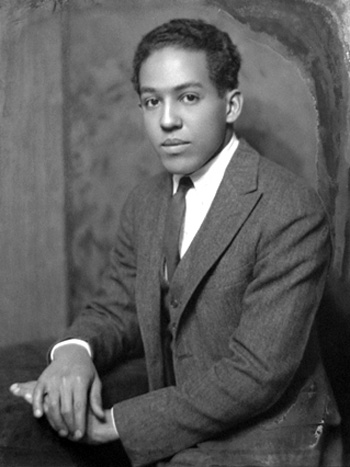
Hughes wrote with sympathy for those who “surrendered amiably to immorality” in the forms of boozing and prostitution, while including a conventionally negative portrayal of a predatory Chicago black male trying to coax his 17-year-old protagonist home with him. The adults in McKay’s fiction are mostly homosocial (choosing to work where men are crammed together and there are no women), though there are uncensorious glimpses of male-male couples in both Home and Banjo.
Schwarz’s book was part of the Nugent revival (or discovery), published before Gentleman Jigger had been published). She does not explain choosing to write about Nugent instead of the leader of the “niggerati,” Wallace Thurman (whose roman-à-clef Infants of the Spring included a pretty openly gay Nugent).
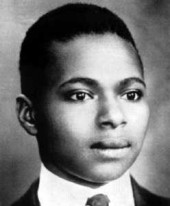
Perhaps because I am far less familiar with Cullen’s work than with that of the other three, I found Schwarz’s chapter on Cullen the most interesting. Having read two books on McKay and one on Nugent, there was less for me to learn about them though I found her analyses of various of their works insightful and mostly convincing (but not her contention that Nugent’s “Geisha Man” is not presented as effeminate) and her cautions about inferring life from works exemplary. Hughes covered his tracks and kept any sexual partners away from his writer acquaintances. Nugent was, perhaps, more homosensual than homosexual, seeking beauty more than “sexual stimulation,” though he accepted labeling as “gay” (and touched as well as gazed at those he saw as beautiful, so perhaps “homoerotic” is a better label…).
An irony in the intra-Harlem war over appropriate subject-matter is that the “tell-it-like-it-is niggerati” occluded their own homosexual relations/relationships. Nugent wrote about ancient (Roman and Biblical) characters and was upbraided by DuBois (after “Smoke, lilies, and jade” appeared in Fire!!) for not writing more about Negroes: “I write about myself, and I’m a Negro, aren’t I?” McKay’s double, Ray, sought and all but swooned over butch black workingmen, though not having sex with any of them on the page.
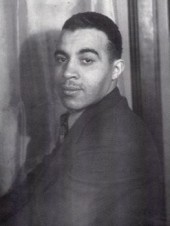
DuBois (speaking for scandalized advocates of presenting uplifting accounts of black success and accomplishments in conventional terms and moral entrepreneurs such as Adam Clayton Powell Sr.) accused the Renaissance naturalists of writing to appeal to the prurient interests of some whites (Carl Van Vechten and his audience who made the Harlem vogue of going to uptown speakeasies during Prohibition) and reinforcing stereotypes of instinct-driven (uncivilized) or degenerated (unnatural) Negroes.
In 1929, Jessie Fauset, a disciple of DuBois who wrote exclusively of the black bourgeoisie sniffed that “publishers best preferred Negro literature that bordered on the pornographic.”
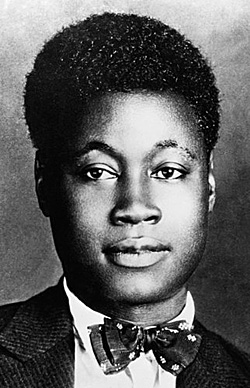
The niggerati in turn thought the writers DuBois published in The Crisis (the official magazine of the NAACP which DuBois edited from 1910 until 1934) were prudish and writing for white approval and claimed that they were “writing for the black masses…who do not appear to have read them.”
To the charge of pandering for sales, Hughes noted in 1927 that he could “make much more money as a bellhop than as a poet.” Hughes proclaimed: “We Negro artists who create now intend to express our individual dark-skinned selves without fear or shame,” and Nugent did not even write for publication. Schwarz wrote of “a fusion of transgressive sexuality, modernism, and racial self-expression” in the contributors to Fire!!.
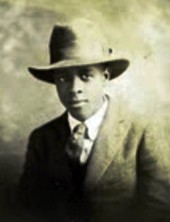
McKay and the niggerati were also more influenced by modernism as well as naturalism (the American exemplar for which was Theodore Dreiser), in contrast to the genteel, traditionally crafted sonnets, etc. of Cullen. Nugent had downtown (Greenwich Village) friends like Parker Tyler (coauthor of the camp classic The Young and the Evil), and the fragmentation of “Smoke, lilies, and jade” is High Modernist.
Hughes did not follow the arcane and elitist example of Ezra Pound and T. S. Eliot but the “democratic” free verse tradition of Walt Whitman that Carl Sandburg was continuing at the same time.
Also, most of what strike me as the best Harlem Renaissance novels (Not Without Laughter, Quicksand, Passing, The Blacker the Berry, Their Eyes Were Watching God), with the exception of Infants of the Spring and Rudolph Fisher’s two novels, were not set in Harlem (even much of Home to Harlem was not), as the last half (or so) of Invisible Man (1952) and all of Go Tell It On the Mountain (1953) were.
©2004, 2016, Stephen O. Murray
originally posted on epinions 13 February 2004

